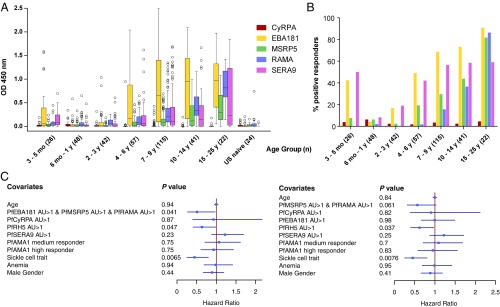Fig. 2.
Antigens are targets of natural IgG responses that are associated with protection from malaria in specific combinations. (A) IgG reactivity against PfCyRPA, PfEBA181, PfMSRP5, PfRAMA, or PfSERA9 in plasma samples from 351 Malians across age groups. Shown is background-subtracted optical density (OD 450 nm) by ELISA. Boxes enclose interquartile range, central lines represent medians, whiskers indicate the 5–95 percentile, and dots are outliers. (B) Seroprevalence of IgG with AUs of >1 against all antigens across age groups. “AU of 1” is defined as the mean OD value plus 3 SDs for 24 malaria-naïve US donors. (C) A Cox regression model was used to evaluate the effect of different combinations of antigen-specific IgG responses on the risk of the first febrile malaria episode of the season using time of first PCR-detectable P. falciparum blood-stage infection as the start time for febrile malaria risk analysis. Shown are forest plots for the most significant combinations that did not include PfRh5.

